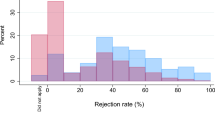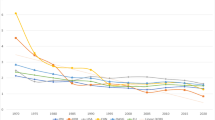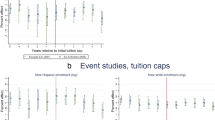Abstract
In this paper, resource dependence theory (RDT) is used to guide an empirical analysis of the higher education system in Uzbekistan. Regression analysis is applied to a panel dataset consisting of 62 Uzbek higher education institutions, covering the period 2000–2013, to examine the determinants of the expenditure decisions made by institutions. The key hypothesis is concerned with the relationship between the share of revenue from tuition fees and the share of expenditure spent on teaching. The analysis attempts to control for unobserved heterogeneity through the inclusion of fixed effects. Instrumental variables estimation is used to address the potential endogeneity of the relationship between these two variables. The main finding is that there is a positive and statistically significant relationship between the share of revenue from tuition fees and the share of expenditure spent on teaching, even after other factors are held constant, which is consistent with a core premise of RDT.










Similar content being viewed by others
References
Albrecht, D., & Ziderman, A. (1995). Financing universities in developing countries. Washington DC: The Falmer Press.
Baltagi, B. H. (2014). The Oxford handbook of panel data. Oxford: Oxford University Press.
Barr, N. (2009). Financing higher education: Lessons from economic theory and reform in England. Higher Education in Europe, 34(2), 201–209.
Barr, N. (2010). Paying for higher education: What policies, in what order? London School of Economics.
Bowden, R. J., & Turkington, D. A. (2008). Instrumental variables. Cambridge: Cambridge University Press.
Canning, M., Godfrey, M., & Holzer-Zelazewska, D. (2007). Higher education financing in the new EU member states. World Bank working paper no. 112.
Casciaro, T., & Piskorski, M. J. (2005). Power imbalance, mutual dependence, and constraint, absorption: A close look at resource dependence theory. Administrative Science Quarterly, 50(2), 167–199.
Central Bank of the Republic of Uzbekistan. (2013). Exchange rates archives. Available from: http://cbu.uz/eng/section/rates.
Coupet, J. (2013). Historically black colleges and universities and resource dependence: A Chow test of production functions. Journal of Higher Education Policy and Management, 35(4), 355–369.
Davis, G. F., & Cobb, J. A. (2010). Chapter 2 Resource dependence theory: Past and future. In Claudia Bird Schoonhoven, Frank Dobbin (ed.) Stanford's Organization Theory Renaissance, 1970–2000 (Research in the Sociology of Organizations, Volume 28) Emerald Group Publishing Limited, 21–42.
Decree of the Cabinet of Ministers of the Republic of Uzbekistan №341. (1997). On state educational standards.
Fowles, J. (2013). Funding and focus: Resource dependence in public higher education. Research in Higher Education, 55(3), 272–287.
Freel, M. S. (2000). Barriers to product innovation in small manufacturing firms. International Small Business Journal, 18(2), 60–80.
Frooman, J. (1999). Stakeholder influence strategies. Academy of Management Review, 24(2), 191–205.
Hillman, A., Shropshire, C., & Cannella, A. (2007). Organizational predictors of women on corporate boards. Academy of Management Journal, 50, 941–952.
Hillman, A. J., Withers, M. C., & Collins, B. J. (2009). Resource dependence theory: A review. Journal of Management, 35(6), 1404–1427.
Johnstone, D. B. (2004). The economics and politics of cost sharing in higher education: Comparative perspectives. Economics of Education Review, 23(4), 403–410.
Johnstone, D. B., & Marcucci, P. N. (2010). Financing higher education worldwide: Who pays? Who should pay? Baltimore: Johns Hopkins University Press.
Koshal, R. K., & Koshal, M. (1999). Economies of scale and scope in higher education: A case of comprehensive universities. Economics of Education Review, 18(2), 269–277.
Ministry of Finance of the Republic of Uzbekistan (2013). Data on higher education of Uzbekistan. Unpublished data.
Ministry of Finance of the Republic of Uzbekistan. (2018). Data on Higher Education of Uzbekistan. Unpublished data.
Muscio, A., Quaglione, D., & Vallanti, G. (2013). Does government funding complement or substitute private research funding to universities? Research Policy, 42, 63–75.
National Human Development Report (2011). Education in Uzbekistan: Matching supply and demand. UNDP Uzbekistan.
Nienhüser, W. (2008). Resource dependence theory—How well does it explain behaviour of organizations? Management Revue, 19(1/2), 9–32.
Ozcan, P., & Eisenhardt, K. M. (2009). Origin of alliance portfolios: entrepreneurs, network strategies, and firm performance. The Academy of Management Journal, 52(2), 246–279.
Paulsen, M. B., & Smart, J. C. (2001). The finance of higher education: Theory, research, policy, and practice. Agathon Press.
Pfeffer, J., & Salancik, G. R. (1978). The external control of organizations: A resource dependence perspective. New York: Harper & Row.
Pilbeam, C. (2012). Pursuing financial stability: A resource dependence perspective on interactions between pro-vice chancellors in a network of universities. Studies in Higher Education, 37(4), 415–429.
Provan, K. G., Beyer, J. M., & Kruytbosch, C. (1980). Environmental linkages and power in resource-dependence relations between organizations. Administrative Science Quarterly, 25, 200–225.
Psacharopoulos, G., & Patrinos, H. A. (2004). Returns to investment in education: A further update. Education Economics, 12(2), 111–134.
Ruziev, K., & Rustamov, D. (2016). Higher education in Uzbekistan: reforms and the changing landscape since independence. University of the West of England, Economics Working Paper Series, 1604.
Saidel, J. R. (1991). Resource interdependence: The relationship between state agencies and nonprofit organizations. Public Administration Review, 51(6), 543–553.
Salmi, J., & Hauptman, A. M. (2006). Innovations in tertiary education financing: A comparative evaluation of allocation mechanisms. Washington, DC: World Bank.
Sam, M. (2011). How should developing countries finance higher education? Institute for Development Policy and Management, University of Manchester.
Sanyal, B. C., & Johnstone, D. B. (2011). International trends in the public and private financing of higher education. UNESCO IBE 2011.
Slaughter, S., & Leslie, L. L. (1997). Academic capitalism: Politics, policies, and the entrepreneurial university. Baltimore: Johns Hopkins University Press.
State Committee on Statistics. (2013). Uzbekistan in figures. Available from: http://www.stat.uz/en/publications/4315/.
EC Tempus (2010). Higher education in Uzbekistan. National Tempus Office, Uzbekistan.
Tilak, J. B. G. (2004). Higher education between the state and the market. UNESCO Forum on Higher Education, Research and Knowledge.
Tolbert, P. S. (1985). Institutional environments and resource dependence: Sources of administrative structure in institutions of higher education. Administrative Science Quarterly, 30, 1–13.
Acknowledgements
We are grateful to the anonymous reviewers and editors for their constructive and helpful comments that considerably improved the quality of this paper. However, the authors are totally responsible for all remaining shortcomings, weakness and errors of omission.
Author information
Authors and Affiliations
Corresponding author
Rights and permissions
About this article
Cite this article
Kholmuminov, S., Kholmuminov, S. & Wright, R.E. Resource dependence theory analysis of higher education institutions in Uzbekistan. High Educ 77, 59–79 (2019). https://doi.org/10.1007/s10734-018-0261-2
Published:
Issue Date:
DOI: https://doi.org/10.1007/s10734-018-0261-2




